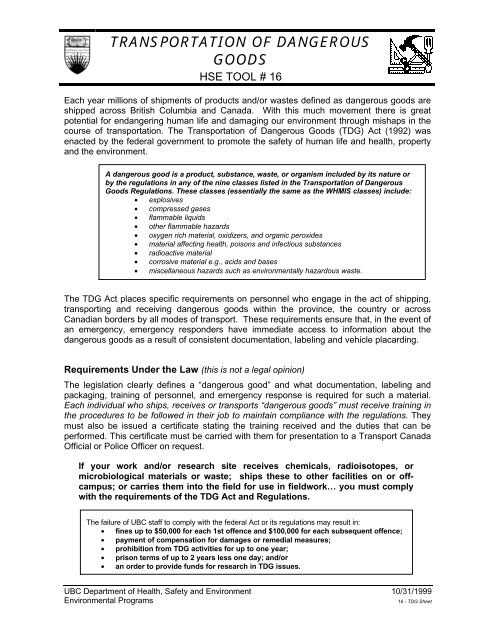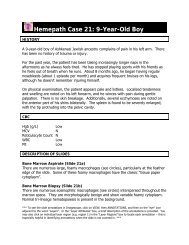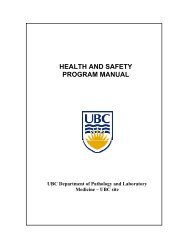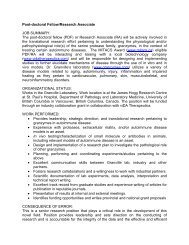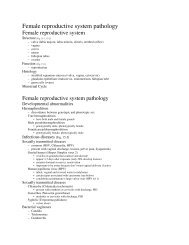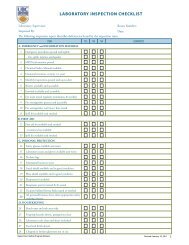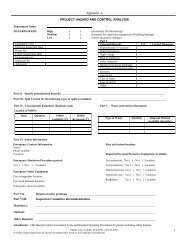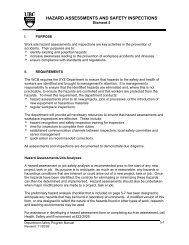transportation of dangerous goods - Pathology and Laboratory ...
transportation of dangerous goods - Pathology and Laboratory ...
transportation of dangerous goods - Pathology and Laboratory ...
You also want an ePaper? Increase the reach of your titles
YUMPU automatically turns print PDFs into web optimized ePapers that Google loves.
TRANSPORTATION OF DANGEROUSGOODSHSE TOOL # 16Each year millions <strong>of</strong> shipments <strong>of</strong> products <strong>and</strong>/or wastes defined as <strong>dangerous</strong> <strong>goods</strong> areshipped across British Columbia <strong>and</strong> Canada. With this much movement there is greatpotential for endangering human life <strong>and</strong> damaging our environment through mishaps in thecourse <strong>of</strong> <strong>transportation</strong>. The Transportation <strong>of</strong> Dangerous Goods (TDG) Act (1992) wasenacted by the federal government to promote the safety <strong>of</strong> human life <strong>and</strong> health, property<strong>and</strong> the environment.A <strong>dangerous</strong> good is a product, substance, waste, or organism included by its nature orby the regulations in any <strong>of</strong> the nine classes listed in the Transportation <strong>of</strong> DangerousGoods Regulations. These classes (essentially the same as the WHMIS classes) include:• explosives• compressed gases• flammable liquids• other flammable hazards• oxygen rich material, oxidizers, <strong>and</strong> organic peroxides• material affecting health, poisons <strong>and</strong> infectious substances• radioactive material• corrosive material e.g., acids <strong>and</strong> bases• miscellaneous hazards such as environmentally hazardous waste.The TDG Act places specific requirements on personnel who engage in the act <strong>of</strong> shipping,transporting <strong>and</strong> receiving <strong>dangerous</strong> <strong>goods</strong> within the province, the country or acrossCanadian borders by all modes <strong>of</strong> transport. These requirements ensure that, in the event <strong>of</strong>an emergency, emergency responders have immediate access to information about the<strong>dangerous</strong> <strong>goods</strong> as a result <strong>of</strong> consistent documentation, labeling <strong>and</strong> vehicle placarding.Requirements Under the Law (this is not a legal opinion)The legislation clearly defines a “<strong>dangerous</strong> good” <strong>and</strong> what documentation, labeling <strong>and</strong>packaging, training <strong>of</strong> personnel, <strong>and</strong> emergency response is required for such a material.Each individual who ships, receives or transports “<strong>dangerous</strong> <strong>goods</strong>” must receive training inthe procedures to be followed in their job to maintain compliance with the regulations. Theymust also be issued a certificate stating the training received <strong>and</strong> the duties that can beperformed. This certificate must be carried with them for presentation to a Transport CanadaOfficial or Police Officer on request.If your work <strong>and</strong>/or research site receives chemicals, radioisotopes, ormicrobiological materials or waste; ships these to other facilities on or <strong>of</strong>fcampus;or carries them into the field for use in fieldwork… you must complywith the requirements <strong>of</strong> the TDG Act <strong>and</strong> Regulations.The failure <strong>of</strong> UBC staff to comply with the federal Act or its regulations may result in:• fines up to $50,000 for each 1st <strong>of</strong>fence <strong>and</strong> $100,000 for each subsequent <strong>of</strong>fence;• payment <strong>of</strong> compensation for damages or remedial measures;• prohibition from TDG activities for up to one year;• prison terms <strong>of</strong> up to 2 years less one day; <strong>and</strong>/or• an order to provide funds for research in TDG issues.UBC Department <strong>of</strong> Health, Safety <strong>and</strong> Environment 10/31/1999Environmental Programs16 - TDG Sheet
TRANSPORTATION OF DANGEROUSGOODSHSE TOOL # 16You know that a material is a <strong>dangerous</strong> good:• if it is a WHMIS-controlled product (usually),• if the supplier states that it is, or it is indicated on the MSDS, or• if it is in Schedule II <strong>of</strong> the TDG Regulations.You may also contact the HSE Chemical Safety Officer (822-5909) for confirmation <strong>of</strong> TDGstatus <strong>of</strong> a material.IF you transport <strong>dangerous</strong> <strong>goods</strong> for work or research ON-CAMPUS you must:• ensure (at a minimum) that− the materials are labeled properly,− you are aware <strong>of</strong> the hazards associated with the material,− you have outer packaging to prevent an accidental release or spill, <strong>and</strong>− you know what to do in the case <strong>of</strong> a spill.• contact the Chemical Safety Officer first if you are planning to use a vehicle for oncampustransport <strong>of</strong> <strong>dangerous</strong> <strong>goods</strong>,• contact the Chemical Safety Officer (822-5909) for information <strong>and</strong> training for anyonewho routinely transports <strong>dangerous</strong> <strong>goods</strong> on campus or departments that are movinglaboratory sites.To re-use boxes that have been used for shipping <strong>dangerous</strong> <strong>goods</strong> (i.e., have TDGlabels):you must deface or remove all TDG labels on the outside <strong>of</strong> the box. It is illegal to transportmaterials with misleading safety marks <strong>and</strong> labels under the TDG Act.If you have been certified <strong>and</strong> trained in TDG by another employer:you must be recertified by UBC, because certification <strong>and</strong> training in TDG is employerspecificunder the regulations. In addition, you must be re-certified by UBC every three (3)years for transport <strong>of</strong> <strong>dangerous</strong> <strong>goods</strong> by road <strong>and</strong> every year for transport by air.If you transport waste materials for your research or work:[except domestic garbage, which is exempted from the TDG regulations] you should contactthe HSE Chemical Safety Officer (822-5909) to confirm what is required. If you transport lessthan 5kg <strong>of</strong> solid waste or 5L <strong>of</strong> liquid waste, you may also be exempted from the TDGregulations.If <strong>of</strong>fice staff receive chemicals or other hazardous materials for your lab or work site:<strong>of</strong>fice staff who receive boxes <strong>of</strong> chemicals from suppliers or couriers must be trained in theTDG Receivers' Course <strong>of</strong>fered by HSE.Health, Safety <strong>and</strong> Environment is working to ensure UBC personnel <strong>and</strong> facilities complywith the TDG regulations. The Chemical Safety Officer may be contacted for moreinformation about TDG training, <strong>and</strong> other TDG questions may be addressed to the HSE<strong>of</strong>fice at 822-2029.UBC Department <strong>of</strong> Health, Safety <strong>and</strong> Environment 10/31/1999Environmental Programs16 - TDG Sheet


